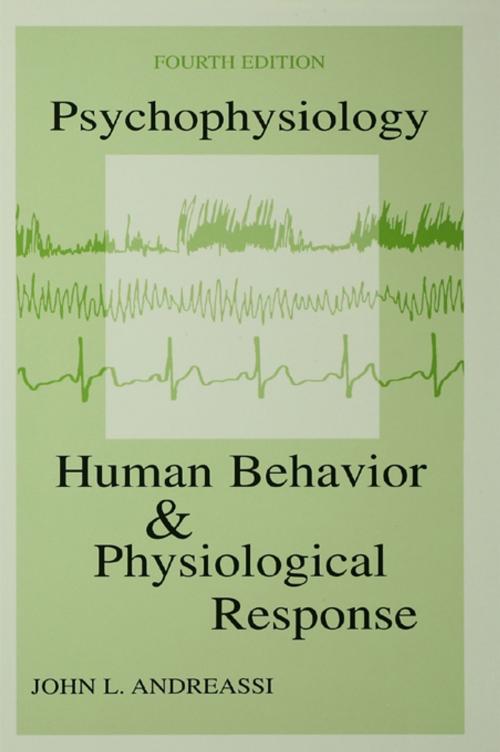Psychophysiology
Human Behavior & Physiological Response
Nonfiction, Health & Well Being, Psychology, Physiological Psychology, Neuropsychology, Cognitive Psychology| Author: | John L. Andreassi | ISBN: | 9781135681180 |
| Publisher: | Taylor and Francis | Publication: | July 23, 2013 |
| Imprint: | Psychology Press | Language: | English |
| Author: | John L. Andreassi |
| ISBN: | 9781135681180 |
| Publisher: | Taylor and Francis |
| Publication: | July 23, 2013 |
| Imprint: | Psychology Press |
| Language: | English |
This highly readable and comprehensive overview of psychophysiology provides information regarding the anatomy and physiology of various body systems, methods of recording their activity, and ways in which these measures relate to human behavior. Biofeedback applications are contained in a separate chapter and discussions of stress management, job strain, and personality factors that affect cardiovascular reactivity are presented. There is much of interest here to the student, researcher, and clinician in behavioral medicine, ergonomics, emotion, cognitive neuroscience, neuropsychology, and health psychology.
Now in its fourth edition, Andreassi's Psychophysiology explores some of the newer areas of importance and updates findings in traditional topics of interest. Significant changes to this edition include:
- updated information on brain activity in memory, perception, and intelligence;
- new information on brain imaging and behavior;
- separate chapters on pupillography and eye movements;
- new information on the startle pattern and eyeblink;
- separate chapters on clinical and non-clinical applications;
- updated information on cardiovascular reactivity and personality;
- the latest biofeedback and ergonomics applications;
- novel findings in environmental psychophysiology;
- brief summaries at the end of each section; and
- an appendix on laboratory safety
Each chapter is a self-contained unit allowing instructors to customize the presentation of the material. With over 1,700 citations, Andreassi's Psychophysiology is the definitive text in the field.
An instructor's manual is now available. Based on the book, the manual is primarily a test bank to be used in giving examinations to students during the teaching of a course. Both multiple-choice and essay questions have been provided, along with lists of key terms and ideas. These can be used for definition-type questions and to highlight important concepts, as well as alerting the instructor to important terms and ideas that they may want to cover in lectures. Sample syllabi are provided for teaching a course at both undergraduate and graduate levels to help the instructor who is preparing a course for the first time. A number of possible laboratory exercises are also provided that can be carried out in conjunction with teaching the course.
This highly readable and comprehensive overview of psychophysiology provides information regarding the anatomy and physiology of various body systems, methods of recording their activity, and ways in which these measures relate to human behavior. Biofeedback applications are contained in a separate chapter and discussions of stress management, job strain, and personality factors that affect cardiovascular reactivity are presented. There is much of interest here to the student, researcher, and clinician in behavioral medicine, ergonomics, emotion, cognitive neuroscience, neuropsychology, and health psychology.
Now in its fourth edition, Andreassi's Psychophysiology explores some of the newer areas of importance and updates findings in traditional topics of interest. Significant changes to this edition include:
- updated information on brain activity in memory, perception, and intelligence;
- new information on brain imaging and behavior;
- separate chapters on pupillography and eye movements;
- new information on the startle pattern and eyeblink;
- separate chapters on clinical and non-clinical applications;
- updated information on cardiovascular reactivity and personality;
- the latest biofeedback and ergonomics applications;
- novel findings in environmental psychophysiology;
- brief summaries at the end of each section; and
- an appendix on laboratory safety
Each chapter is a self-contained unit allowing instructors to customize the presentation of the material. With over 1,700 citations, Andreassi's Psychophysiology is the definitive text in the field.
An instructor's manual is now available. Based on the book, the manual is primarily a test bank to be used in giving examinations to students during the teaching of a course. Both multiple-choice and essay questions have been provided, along with lists of key terms and ideas. These can be used for definition-type questions and to highlight important concepts, as well as alerting the instructor to important terms and ideas that they may want to cover in lectures. Sample syllabi are provided for teaching a course at both undergraduate and graduate levels to help the instructor who is preparing a course for the first time. A number of possible laboratory exercises are also provided that can be carried out in conjunction with teaching the course.















